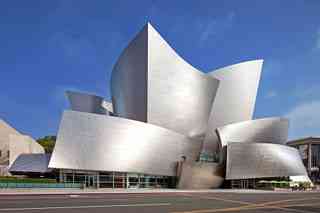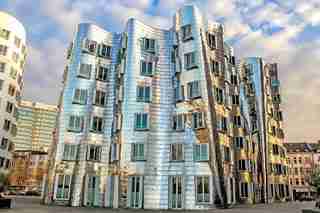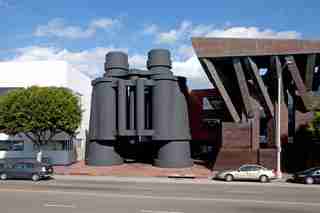It's not often the case that architects grow to become household names. But Frank Gehry has never lived by any common practice. The award-winning architect has spent more than a half-century disrupting the very meaning of design within architecture. From the iconic Guggenheim Museum Bilbao (which Philip Johnson called “the greatest building of our time") to the Fondation Louis Vuitton in Paris, Gehry has proven time and again the force that's produced when whimsical design is done masterfully. Born in Canada in 1929, Gehry attended the University of Southern California and the Harvard Graduate School of Design. He began his career in Los Angeles working for Victor Gruen Associates and Pereira and Luckman. After a brief stint in Paris working with Andre Remondet, he returned to California and started his own firm in 1962. Gehry was awarded the Pritzker Prize in 1989. A man with seemingly no limits, there is no bad time to celebrate Gehry's oeuvre. Below, AD survey's thirty-one of his most recognizable structures from around the world.

Walt Disney Concert Hall, Los Angeles, California
Gehry was shortlisted to devise a new home for the Los Angeles Philharmonic in 1988; the project, the Walt Disney Concert Hall, finally opened in 2003. Today critics and the public agree that the iconic building was worth the wait. Reflecting Gehry’s longtime passion for sailing, the structure’s exterior features expanses of stainless steel that billow above Grand Avenue, while inside, similarly shaped panels of Douglas fir line the auditorium.

Neuer Zollhof, Dusseldorf, Germany
Gehry’s Neuer Zollhof complex spurred the transformation of Dusseldorf, Germany’s waterfront into what is now called the Media Harbour in 1999. The popularity of the trio of office buildings yielded nearby commissions for other prominent architects like Fumihiko Maki and Murphy/Jahn, and earned the three towers a spot in the Germand edition of Monopoly.

Chiat/Day Complex, Venice, California
The 1991 Venice, California, complex that Gehry built for advertising agency Chiat/Day commonly goes by the nickname Binoculars Building, thanks to the enormous pair of binoculars that mark the entrance to a parking garage—a collaboration between Gehry and artists Claes Oldenburg and Coosje van Bruggen. Office structures resembling a ship’s prow and tree trunks flank the sculpture, which now welcomes 500 Google employees to work every day.
Vitra Design Museum, Weil am Rhein, Germany
Since the early 1980s, furniture manufacturer Vitra has enlisted up-and-coming architects to create buildings for its campus in Weil am Rhein. Among them is Gehry's Vitra Design Museum, which opened in 1989. For the 8,000-square-foot venue, Gehry piled simple simple geometric forms against a cubic volume, unifying them all with white plaster surfaces and zinc roofing.
Gehry House, Santa Monica, California
Gehry’s first significant brush with fame came with the 1978 construction of a Santa Monica residence he designed for himself and his family. The project wrapped an existing bungalow in angular volumes clad in a riot of everyday suburban materials like plywood and chain link. As opinionated as it was sculptural, the house earned both cheers and jeers in short order. In 2012 it won the American Institute of Architects’ prestigious Twenty-Five Year Award.
Loyola Law School, Los Angeles, California
The 1978 commission to expand Loyola Law School would propel Gehry into institutional work. He reimagined Loyola’s downtown Los Angeles site as a neotraditional campus, arranging a stylistically diverse set of buildings and surrounding them with a knoll-like landscape. During initial design work, a strategy was developed to allow the expansion of the campus in several phases, corresponding to the priorities of the school. The last phase of the design was completed in 2003.
Olympic Fish Pavilion, Barcelona, Spain
The monumental golden steel-mesh fish sculpture Gehry created for the 1992 Olympic Village in Barcelona represented a technological breakthrough for the architect’s studio, which used three-dimensional aeronautical-design software to realize the concept.
Weisman Art Museum, Minneapolis, Minnesota
Completed in 1993, the Weisman Art Museum is located on the University of Minnesota campus. Its western façade, featuring steel-clad turrets and bays, peeks over the bluffs of the Mississippi River. Construction of a Gehry-designed expansion concluded in 2011.
Dancing House, Prague, Czech Republic
The Prague offices of the Dutch insurance company Nationale-Nederlanden is also known as Fred and Ginger, thanks to its signature pair of towers, which seem to resemble a couple dancing. The 1996 building, comprising a cinched volume of metal mesh and glass and a concrete cylinder, was a collaboration between Gehry and local architect Vlado Miluníc.
Guggenheim Bilbao, Spain
The Guggenheim’s satellite in Bilbao, Spain, multiplied the museum’s exhibition space in a mountain of stone, glass, and titanium that follows the contours of the Nervión river. Design and construction of the Guggenheim Bilbao went largely unnoticed in the press, so the building’s 1997 opening produced an explosion of publicity, securing Gehry’s place as a master among architects and jolting the Bilbao economy.
Davis Studio and Residence, Malibu, California
Frank Gehry completed this Malibu live/work residence for artist Ron Davis in 1968, six years after he launched his architecture practice in Los Angeles. While the Davis commission was not Gehry’s first project, it did presage his signature design vocabulary, thanks to a slanted roof that makes the trapezoidal house appear to torque. Today the place is home to actor Patrick Dempsey and his family. (See *AD’*s March 2014 cover story, "California Dreamy," featuring the Dempseys’ house.)
DZ Bank Building, Berlin, Germany
In Berlin, local code prohibits any building from outshining Brandenburg Gate. Commissioned by Frankfurt-based DZ Bank & Hines to design a branch across from the triumphal arch, Gehry created a sober limestone façade in response. A spectacular stainless-steel conference room—whose shape Gehry has likened to a horse’s head—is tucked within the atrium of the now-14-year-old office building.
EMP Museum, Seattle, Washington
At the base of the Space Needle, Gehry framed the EMP Museum to look as if its steel-and-aluminum skin is flapping in the wake of Seattle’s famous monorail. The EMP Museum is the brainchild of Microsoft cofounder Paul Allen, and, upon its completion in 2000, was inaugurated as the Experience Music Project. Gehry’s first model of the museum was built from sliced-up guitars.
Peter B. Lewis Building, Cleveland, Ohio
Since its construction in 2002, the Peter B. Lewis Building has housed the Weatherhead School of Management at Cleveland’s Case Western Reserve University. The building exterior is classic Gehry, with ribbons of stainless steel unfurling from a brick base. The open interior is meant to encourage cross-disciplinary socializing.
Richard B. Fisher Center, Annandale-on-Hudson, New York
Likening the structure’s stainless-steel façade to a theatrical mask, Gehry finished the Richard B. Fisher Center for the Performing Arts at New York’s Bard College in 2003. Although he has been criticized for not advocating sustainability strongly enough, the architect incorporated geothermal energy systems and other green strategies into the building's design, allowing the edifice to run largely free of fossil fuels.
Jay Pritzker Pavilion, Chicago, Illinois
The Jay Pritzker Pavilion was a centerpiece in the transformation of downtown Chicago rail yards into Millennium Park public square. Gehry framed the performance venue in brushed stainless-steel ribbons, which reach out toward the Great Lawn in the form of steel piping that also encloses sound distribution. The audio system has been treating audiences to concert-hall acoustics for more than a decade.
Stata Center, Cambridge, Massachusetts
The Ray and Maria Stata Center for Computer, Information and Intelligence Sciences replaced Massachusetts Institute of Technology’s Building 20 in 2004. Its predecessor had enjoyed mythological status as a place where scientists engaged in unexpected yet highly successful collaborations. Gehry designed the Stata Center specifically to encourage occupants to interact with one another.
The IAC Building, New York, New York
Gehry realized his first Manhattan building in 2007, with the completion of the InterActiveCorp headquarters in the city’s Chelsea neighborhood. The nine-story edifice was also his first major glass building, and crews bent that material on site to capture the swelling effects in his sailboat-like design.
Art Gallery of Ontario (renovation), Toronto, Canada
Born in Toronto in 1929, Gehry celebrated his first Canadian project there, a renovation of the Art Gallery of Ontario, just a few months shy of turning 80. The 1918 museum had already undergone expansion three times prior to the Gehry commission. In response, the architect reorganized the jumbled plan and inserted a variety of energetic and subdued volumes for additional exhibition space.
Beekman Tower, New York, New York
Ripples run across the exterior of Manhattan’s Beekman Tower—dubbed 8 Spruce Street—as if a giant Super Ball had ricocheted through its interior. These pleats also function as bay windows for residents of the 76-story apartment building, which opened in 2011 and was commissioned by the development firm Forest City Ratner Co.
New World Center, Miami, Florida
Gehry composed the New World Center in Miami Beach as an uncharacteristic boxlike volume. A six-story glass curtain wall allows the public outside to look into the atrium, which contains several distinctly shaped rehearsal rooms. These spaces have theatrical lighting and performances can be seen from an adjacent park. People in the park can also watch concerts on a 7,000-square-foot outdoor projection screen.
Cinémathèque Française, Paris, France
Gehry’s building along Paris’s rue de Bercy opened in 1994 as the headquarters of the American Center of Paris, but closed a year and a half later. In 2005 it became home to the Cinémathèque Française, a theater and archive of film history.
Marta Herford, Herford, Germany
Gehry combined red brick with a gleaming stainless-steel roof for the Marta Herford contemporary art museum. Completed in 2005, the design incorporates a former textile factory that existed on the site.
Fondation Louis Vuitton, Paris, France
Commissioned by LVMH chief Bernard Arnault and completed in 2014, Frank Gehry’s Fondation Louis Vuitton is set in Paris’s Bois de Boulogne park. The shiplike exterior includes 12 glass “sails,” which cover the concrete-clad gallery spaces.
Serpentine Gallery Summer Pavilion, London, England
In 2008, Frank Gehry designed the Serpentine Gallery Pavilion in London for the popular modern and contemporary art exhibition. The structure, which consisted of four wood-clad steel columns that were being supported by a series of large timber planks and beams, was part-amphitheatre, part-promenade. The temporary exhibit also featured sheets of transparent glass as a roof to shelter the promenade.
Lou Ruvo Center, Las Vegas, Nevada
The Lou Ruvo Center for Brain Health was conceived by Las Vegas entrepreneur Larry Ruvo, whose father died of complications related to Alzheimer’s disease. In 2009 the Cleveland Clinic agreed to run the multifaceted medical center and research facility, which features a steel-clad event space anchored to a clinic and office building via a latticework courtyard.
Maggie’s Centre, Dundee, Scotland
Located on the grounds of National Health Service hospitals across Great Britain, Maggie’s Centres are support facilities for cancer patients, designed by renowned architects and operated according to principles devised by its founder, its cofounder, the landscape architect Maggie Keswick Jencks. Gehry completed the first new-build Maggie’s Centre in 2003.
Biomuseo, Panama City, Panama
In the late 1990s, Panamanian leaders, hoping to produce their own “Bilbao Effect,” began speaking with Gehry about designing an ecology museum. But it wasn’t until 2013 that the project was finally realized. The newly opened Biomuseo marks Panama City’s Amador Causeway with a colorfully crumpled roofline, held in place by what appears to be an oversize billboard structure. Revealing underlying armature is a traditional Gehry trope, but his uncharacteristic choice of reds, greens, and other bold hues is a direct nod to Panama's diverse flora and fauna.
Dr. Chau Chak Wing Building, Sydney, Australia
The Dr. Chau Chak Wing Building at the University of Technology Sydney Business School, which opened in 2015, is Gehry’s first project in Australia. The undulating brick building includes a number of sustainability features throughout its 11 floors.
Marqués de Riscal, Elciego, Spain
The Marqués de Riscal, built in 2006, was Gehry's first completed hotel. The luxury lodging is located in a small town known for its vineyards and wineries. Much like how Gehry’s Guggenheim Museum Bilbao rejuvenated that Spanish city, Marqués de Riscal has brought more tourists to this region of the country.
Gehry Tower, Hanover, Germany
The Gehry Tower, which was completed in 2001, is located in central Germany. Built of stainless steel, the structure features a twisted façade, which allows for the most use of office space in a relatively small bit of real estate.
